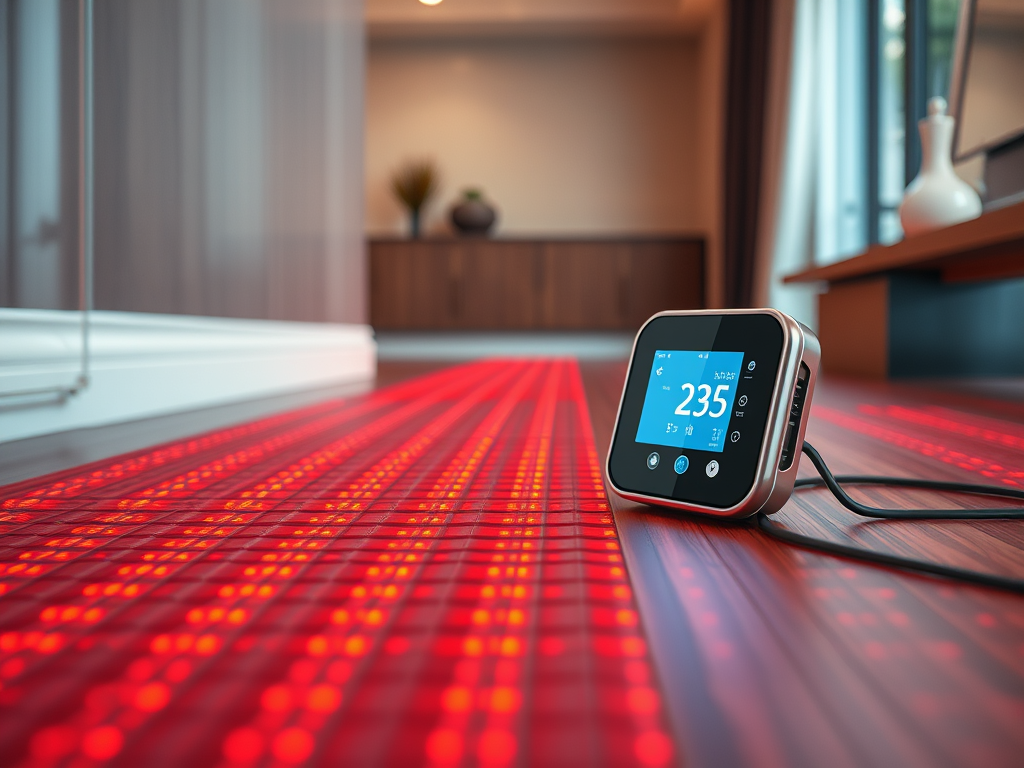Revolutionizing Comfort: The Digitalization of Floor Heating Systems

Underfloor heating systems are becoming an increasingly popular choice for providing warmth and comfort in residential and commercial spaces. These systems, driven by digitalization, include various types, most notably radiant, electric and hydronic heating, each of which operates on different principles while offering increased comfort compared to traditional heating methods. Radiant underfloor heating is particularly notable for its ability to provide an even distribution of heat throughout the space, eliminating cold spots and creating a cozy atmosphere. This type involves installing heating cables or mats under the floor surface, which heats the floor and therefore the air in the room.
Electric floor heating systems, on the other hand, utilize electric wires or heating mats installed under the flooring. These systems are often easier to install, making them a favorable option in retrofitting projects where existing structures cannot support a hydronic approach. Electric systems offer rapid responses to temperature changes, allowing users to enjoy immediate warmth when needed.
Hydronic systems circulate heated water through pipes laid beneath the flooring. This method is often considered highly energy-efficient, especially when combined with alternative energy sources such as solar heating or heat pumps. By controlling the water temperature, users are able to customize the heating to meet specific comfort levels, further demonstrating the advantage of floor heating systems.
One of the primary benefits of floor heating system is the enhanced comfort they provide. Unlike traditional radiators that unevenly heat a room, floor heating systems maintain a steady and pleasant ambient temperature. Additionally, these systems tend to consume less energy, leading to lower utility bills, especially in well-insulated spaces. Beyond comfort and energy efficiency, floor heating systems offer aesthetic advantages, allowing for a wider range of flooring options without the need for bulky radiators or ducts. As we delve deeper into the transformative effects of digitalization, we will explore how these systems are becoming smarter, more efficient, and tailored to modern lifestyles.
The Impact of Digitalization on Floor Heating Systems
The advent of digitalization has fundamentally transformed various home technologies, and floor heating systems are no exception. This evolution is primarily driven by the integration of smart thermostats, Internet of Things (IoT) devices, and sophisticated energy monitoring systems. These innovations enable homeowners to take full control of their heating systems remotely, enhancing both comfort and convenience.
Smart thermostats are pivotal in this transformation. They allow users to adjust temperature settings from their smartphones or tablets, ensuring optimal warmth without the need for physical interaction. This remote accessibility supports a personalized heating experience tailored to individual preferences and schedules. For instance, a homeowner can increase the temperature in the morning before getting out of bed or lower it during the day when the house is unoccupied, significantly improving the overall thermal comfort.
Furthermore, the integration of IoT devices contributes to the efficiency of floor heating systems. These devices collect and analyze data on energy consumption and system performance in real time. This allows users to understand their heating usage patterns and adjust accordingly, leading to significant energy savings. Homeowners can receive alerts on maintenance needs or unusual heating patterns, thus preventing costly repairs and ensuring continuous performance without interruption.
Case studies highlight the impressive results of these digital enhancements. For example, a survey of households integrating smart heating management showed a decrease in energy bills by up to 30% while maintaining desired comfort levels. By employing digital tools, they could also monitor their carbon footprint, contributing positively to environmental sustainability.
As digital technology continues to evolve, so too will the functionalities of floor heating systems, making them smarter and more energy-efficient. The digitalization of heating solutions is not merely a trend; it represents a significant advancement towards a more comfortable and sustainable living environment.
Benefits of Smart Floor Heating Solutions
The evolution of floor heating systems has been significantly influenced by digitalization, leading to numerous advantages for consumers. One of the primary benefits is enhanced energy efficiency. Smart floor heating solutions utilize advanced sensors and algorithms to distribute heat evenly and more effectively than traditional systems. According to industry reports, homes equipped with digitalized heating systems can experience energy savings of up to 30%. This reduction in energy usage not only results in lower utility bills but also contributes to a more sustainable environment by decreasing overall energy consumption.
Another advantage of these innovative systems is the increased comfort they provide. With digital thermostat controls, users can tailor their indoor temperatures to their specific preferences. This level of precise temperature control ensures that every room in a home can be maintained at an optimal comfort level, responding immediately to any changes in the environment. Research shows that individuals experience a greater sense of satisfaction when their heating systems are easily modifiable and responsive to their needs.
The convenience offered by programmable heat settings is yet another significant benefit. Homeowners can set their heating schedules according to their daily routines, ensuring that spaces are warm when needed and conserving energy during periods of inactivity. Many digital floor heating solutions can be controlled remotely via smartphone applications, making it possible to adjust settings even when away from home. Additionally, these systems often come equipped with features that allow for the analysis of energy usage patterns, enabling users to make informed decisions about their heating practices.
Ultimately, the integration of digital technology in floor heating system not only enhances the comfort and convenience of home heating but also fosters eco-friendliness by promoting more responsible energy consumption. The continued advancement of these digital solutions promises to reshape the way consumers experience and interact with their heating systems.
Future Trends and Innovations in Floor Heating Digitalization
The landscape of floor heating systems is evolving rapidly, driven by the growing emphasis on energy efficiency and user experience. One notable trend is the integration of smart home technology, enabling consumers to control their heating systems remotely through mobile applications. This digitalization allows homeowners to optimize comfort levels based on individual preferences and energy consumption patterns. The use of smart thermostats, which can learn the typical behaviors of occupants, facilitates automated adjustments, further enhancing efficiency and convenience.
Another significant innovation lies in machine learning applications for predictive maintenance. By utilizing data analytics, these systems can anticipate potential malfunctions or inefficiencies before they become critical issues. This analytical approach not only minimizes downtime but also extends the lifespan of the floor heating systems, ultimately leading to cost savings for homeowners. As technology progresses, we can anticipate further integration of artificial intelligence, which will sharpen the predictive capabilities of these systems.
Additionally, advancements in materials and technologies play a crucial role in improving the performance of digitalized floor heating systems. New materials with better thermal conductivity and lower energy usage are being developed, offering enhanced warmth and comfort while adhering to environmental standards. Moreover, innovation in insulation materials is set to maximize energy efficiency, ensuring that heat is retained within the living spaces.
Stay tuned for daily cryptocurrency news!
However, as homeowners consider transitioning to these modern systems, they must also navigate a few challenges. Initial installation costs, the need for professional assessment, and potential disruption during retrofitting are critical aspects to weigh. Educating oneself about evolving consumer expectations will empower homeowners to make informed decisions regarding their heating solutions. As digitalization continues to revolutionize floor heating systems, staying abreast of these trends will ensure a future of unparalleled comfort and efficiency.




